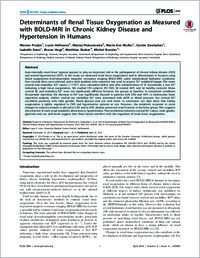Determinants of renal tissue oxygenation as measured with BOLD-MRI in chronic kidney disease and hypertension in humans.
- Pruijm M Department of Nephrology, University Hospital, Lausanne, Switzerland.
- Hofmann L Department of Nephrology and Hypertension, Bern University Hospital, Bern, Switzerland.
- Piskunowicz M Department of Radiology, Medical University of Gdansk, Gdansk, Poland.
- Muller ME Department of Nephrology, University Hospital, Lausanne, Switzerland.
- Zweiacker C Department of Nephrology, University Hospital, Lausanne, Switzerland.
- Bassi I Department of Nephrology, University Hospital, Lausanne, Switzerland.
- Vogt B Department of Nephrology and Hypertension, Bern University Hospital, Bern, Switzerland.
- Stuber M Department of Radiology, University Hospital, Lausanne, Switzerland.
- Burnier M Department of Nephrology, University Hospital, Lausanne, Switzerland.
- 2014-04-25
Published in:
- PloS one. - 2014
Administration, Intravenous
Adult
Aged
Case-Control Studies
Cell Hypoxia
Diuretics
Female
Furosemide
Humans
Hypertension
Kidney
Kidney Cortex
Kidney Medulla
Magnetic Resonance Imaging
Male
Middle Aged
Oxygen
Oxygen Consumption
Renal Insufficiency, Chronic
English
Experimentally renal tissue hypoxia appears to play an important role in the pathogenesis of chronic kidney disease (CKD) and arterial hypertension (AHT). In this study we measured renal tissue oxygenation and its determinants in humans using blood oxygenation level-dependent magnetic resonance imaging (BOLD-MRI) under standardized hydration conditions. Four coronal slices were selected, and a multi gradient echo sequence was used to acquire T2* weighted images. The mean cortical and medullary R2* values ( = 1/T2*) were calculated before and after administration of IV furosemide, a low R2* indicating a high tissue oxygenation. We studied 195 subjects (95 CKD, 58 treated AHT, and 42 healthy controls). Mean cortical R2 and medullary R2* were not significantly different between the groups at baseline. In stimulated conditions (furosemide injection), the decrease in R2* was significantly blunted in patients with CKD and AHT. In multivariate linear regression analyses, neither cortical nor medullary R2* were associated with eGFR or blood pressure, but cortical R2* correlated positively with male gender, blood glucose and uric acid levels. In conclusion, our data show that kidney oxygenation is tightly regulated in CKD and hypertensive patients at rest. However, the metabolic response to acute changes in sodium transport is altered in CKD and in AHT, despite preserved renal function in the latter group. This suggests the presence of early renal metabolic alterations in hypertension. The correlations between cortical R2* values, male gender, glycemia and uric acid levels suggest that these factors interfere with the regulation of renal tissue oxygenation.
- Language
-
- English
- Open access status
- gold
- Identifiers
-
- DOI 10.1371/journal.pone.0095895
- PMID 24760031
- Persistent URL
- https://folia.unifr.ch/global/documents/59450
Statistics
Document views: 7
File downloads:
- fulltext.pdf: 0
